Physical Address
304 North Cardinal St.
Dorchester Center, MA 02124
The meibomian glands in the upper and lower eyelids play a critical role in forming and maintaining a viable tear film. Specifically, these glands produce a clear, oily secretion that serves two main functions: (1) forming a hydrophobic lining along the lid margins, thus preventing epiphora, and (2) maintaining a thin lipid layer over the surface of the aqueous tear phase, which retards evaporative fluid loss.
Meibomian gland dysfunction (MGD) may be defined as a chronic, diffuse abnormality of the meibomian glands, commonly characterised by terminal duct obstruction and/or qualitative/quantitative changes in the glandular secretion. This may result in alteration of the tear film, symptoms of eye irritation, clinically apparent inflammation and ocular surface disease.
Some authors previously used the terms ‘posterior blepharitis’ and ‘MGD’ as if they were synonymous, but these terms are not interchangeable. Posterior blepharitis is a term used to describe inflammatory conditions of the posterior lid margin, of which MGD is only one cause (see Chapter 8 ).
Figure 7.1 sets out a classification schema for MGD, as devised by the International Workshop on Meibomian Gland Dysfunction. As will be discussed throughout this chapter, there are differing opinions as to whether contact lens wear causes, exacerbates or coincidentally co-exists with MGD. Whatever the answer, the classification schema shown in Figure 7.1 provides a useful framework for considering contact lens–associated MGD (CL-MGD).
The meibomian (tarsal) gland orifices emerge just anterior to the mucocutaneous junction. By using broad diffuse illumination at high magnification (×40), round or slightly oval meibomian gland orifices can be seen just in front of the mucocutaneous junction ( Fig. 7.2 ).
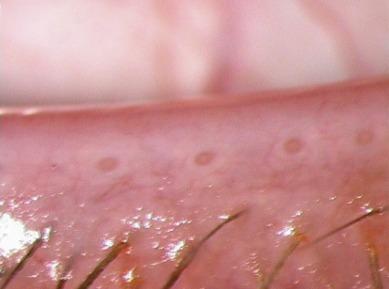
There are about 30 to 40 vertically oriented meibomian glands in the upper lid, which open onto small, round orifices in the upper margin. There are slightly fewer meibomian glands – about 20 to 40 in number – which open into the lower lid margin. The meibomian glands in the lower lid margin are shorter in length and slightly wider than those in the upper lid. In both the upper and lower lids, the meibomian glands are approximately uniformly distributed from inner to outer canthus ( Fig. 7.3 ).
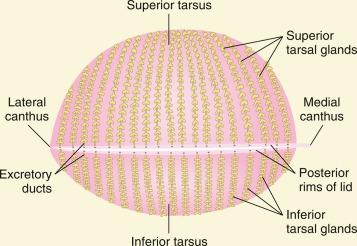
The tarsal plates contain the acini and ducts of the meibomian (tarsal) glands. The vertically oriented ducts, which run perpendicular to the lid margins, are connected to multiple secretory acini, which open laterally onto each duct ( Fig. 7.4 A ). The glands occupy nearly the full length and width of each tarsus.

Acini are lined by a layer of undifferentiated basal cells that divide, and cells are displaced from the basement membrane. As they progress toward the duct, they gradually enlarge and develop lipid droplets in their cytoplasm. Ultimately, cell membranes rupture and cellular debris, together with the lipid product, is discharged into the duct ( Fig. 7.4 B).
Meibomian gland acini can also be imaged by using laser scanning confocal microscopy ( Fig. 7.4 B). The layer of undifferentiated basal cells that line the acini can be clearly identified, and granular material can be seen within the acini, which are presumed to be ruptured cells and lipid droplets.
The stimulus for meibomian gland secretion is unclear. Although a modest autonomic innervation of the meibomian glands has been demonstrated, there is still some doubt regarding a neuromodulation of glandular secretion, and it is likely that the principal control of the glands is hormonal and that both androgen and oestrogen have been shown to regulate meibomian secretion. A long ductal system carries the secretion to the lid margin, and the compressive action of the palpebral division of the orbicularis oculi on the meibomian ducts facilitates the flow of lipid and its eventual delivery onto the lid margins.
Korb and Henriquez found that 36.6% of symptomatic contact lens wearers manifested abnormalities of meibomian gland orifices versus 2.5% of asymptomatic wearers. Ong examined the eyes of 81 contact lens wearers and 150 age- and gender-matched non–lens wearers for evidence of MGD. The prevalence of CL-MGD was 49% versus 39% among the controls; this difference was not statistically significant, and this suggests that contact lens wear is not a cause of MGD.
Hom et al. conducted a survey of 398 normal individuals presenting for a routine eye examination. Based on the principal clinical criterion of an absent or cloudy meibomian gland secretion upon expression, 39% of the patients were found to have MGD. The prevalence of MGD was significantly increased with increasing age, and this is in accordance with the finding of Stanek. Hom et al. reported that the prevalence of MGD was 41% among contact lens wearers and 38% among non–lens wearers. These figures broadly agree with those of Ong (49% and 39%, respectively).
Molinari and Stanek reported that 22% of contact lens wearers exhibited MGD. In a retrospective study of 141 patients attending a hospital outpatient clinic with complaints of discomfort while wearing contact lenses, blepharitis and CL-MGD were noted in 32% of cases. Young et al. reported that the prevalence of CL-MGD among 226 symptomatic contact lens wearers was 14% in a multi-centre study.
Stanek evaluated the meibomian gland status of active-duty military forces (younger population) and US military veterans (older population). One examiner observed 113 consecutive patients in both groups during a 2-week period. MGD was observed in 9.7% of the younger population (about half of these were contact lens wearers) versus 71.1% of the older patients (none wore contact lenses). These finding suggest a higher prevalence of MGD with increasing age.
Sapkota et al. reported that MGD represented 8.6% of complications relating to contact lens wear in cases seen during the period 2003 to 2010 in a large hospital in Nepal.
Ong and Larke reported that the prevalence of MGD and CL-MGD is unrelated to gender.
There are various signs of CL-MGD, but not all will be evident in any given lens wearer. Although slit lamp biomicroscopy is the cornerstone procedure when investigating this condition, ancillary procedures may need to be employed to assist in making a definitive diagnosis and for assessing the severity of the condition. The various signs of CL-MGD and investigative techniques are considered here.
The procedure of observing the morphology of the meibomian glands using specialised illumination and observation techniques is known as meibography . When using this method, the structure of the meibomian glands, including the ducts and acini, can be observed.
Before observing meibomian glands in the upper lid, the tarsal conjunctiva must be exposed by everting the lid. Before observing meibomian glands in the lower lid, the tarsal conjunctiva must be exposed by placing the forefinger on the skin just beneath the lower lid margin and gently pulling downward.
Two forms of meibography have been described. A transillumination technique, in which the eyelid is everted over a light source, can be used. The most basic version uses white light, for example, from a Finoff transilluminator. This is applied to the cutaneous side of the everted eyelid and allows for observation from the palpebral conjunctival surface. As such, this is a contact technique that can cause mild discomfort to the patient.
Direct, non-contact infrared meibography involves the employment of an infrared charge-coupled device video camera and infrared light source that does not touch the patient during the procedure. An infrared transmitting filter is required to facilitate observation of the everted lid. The meibomian glands appear as white structures against a dark background ( Fig. 7.5 ).
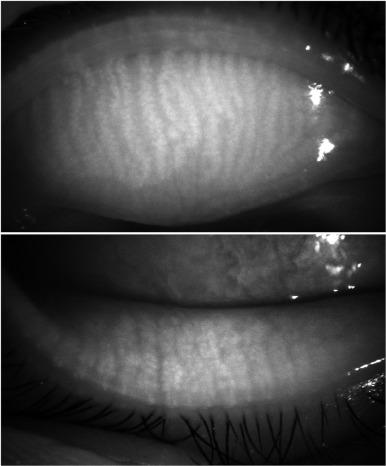
Although meibography has been conducted for many years in a research setting, a number of non-invasive, clinician-friendly devices have recently been released, making meibography possible as a routine procedure within clinical practice. Two of these devices include the Keratograph 5M (OCULUS, Wetzlar, Germany) and the LipiScan Dynamic Meibomian Imager (TearScience, Johnson and Johnson Vision, Morrisville, North Carolina, USA) ( Fig. 7.6 ). The LipiScan offers a feature that combines dynamic illumination and adaptive transillumination to generate an enhanced view of meibomian gland structure ( Fig. 7.7 ).
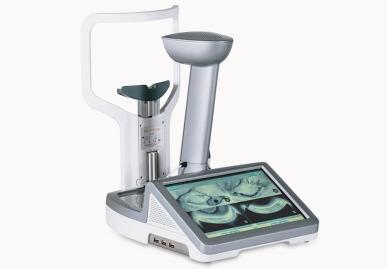
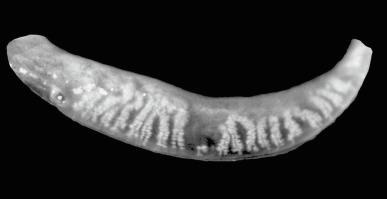
Pult and Riede-Pult devised a schema for grading the level of severity of meibomian gland pathology of the lower lid, known as the meiboscale . This instrument was subsequently enhanced to contain separate scales for the upper and lower lids ( Fig. 7.8 ). Each scale consists of a series of meibography images that progress from ‘degree 0’ (normal; 0% gland dropout/atrophy) to ‘degree 4’ (severe; > 75% gland drop-out/atrophy). Each meibography image is accompanied by a schematic drawing of the level of severity. The progression of severity is also indicated by colour coding, from green (normal) to red (severe). A central panel illustrates meibomian glands with various forms of pathology.
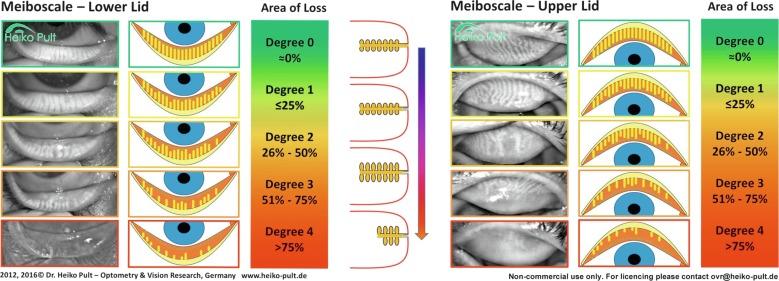
Arita et al. investigated the influence of contact lens wear on meibomian glands by using non-contact meibography. Partial or complete loss of the meibomian glands was scored for each eyelid using four grades (meiboscores): grade 0 (no loss of meibomian glands) through grade 3 (the area characterised by gland drop-out was > 66% of the total area containing the meibomian glands). The meiboscore was significantly higher (p < 0.0001) in contact lens wearers (mean 1.72; 95% confidence interval (CI) 1.47–1.96) compared with that in the control group (0.96 (95% CI 0.73–1.19)). The average meiboscore of contact lens wearers was similar to that of the 60- to 69-year-old age group from the normal population. A significant positive correlation was observed between the duration of contact lens wear and the meiboscore. The authors concluded that contact lens wear is associated with a decrease in the number of functional meibomian glands. This decrease is proportional to the duration of contact lens wear.
Tang et al. evaluated meibomian gland morphology, by using meiboscore and digital analysis, among 60 subjects categorised as non–contact lens wearers, short-term contact lens wearers (≤ 3 years) and long-term contact lens wearers (> 3 years). The median percentage area of meibomian gland loss in the upper eyelid of the non-wear, short-term wear and long-term wear groups was 9.2%, 13.3% and 16.7%, respectively (Hc = 6.390; p = 0.041). The total (upper and lower lid) median percentage area of meibomian gland loss of the non-wear, short-term wear and long-term wear groups were 6.6%, 8.8% and 13.0%, respectively (Hc = 7.019; p = 0.030). The authors concluded that long-term (> 3 years) contact lens wear can cause meibomian gland loss.
Pucker et al. graded upper and lower eyelid meibomian gland atrophy with both digital meibography and visual meiboscore methods in 70 contact lens wearers (case) and 70 age- and gender-matched non–contact lens wearers with no history of lens use. All subjects were administered the Ocular Surface Disease Index questionnaire and a comprehensive battery of clinical tests (e.g. tear break-up time (TBUT), bulbar and limbal redness, meibography, etc.) were performed. The association between contact lens wear and meiboscore was not significant in univariate analysis, but the best-fitting multivariate regression model showed that higher meiboscores were associated with being a contact lens wearer (odds ratio (OR) 2.45). Percent gland atrophy was not associated with contact lens wear in the regression analysis (p = 0.31). In view of these findings, the authors considered that associations between contact lens wear and meibomian gland atrophy were inconclusive.
The presence of distended or distorted meibomian glands confirms the diagnosis of cicatricial obstructive CL-MGD. These are sometimes visible when viewed with the slit lamp biomicroscope under low magnification (× 6) and a broad illumination beam of white light.
On eversion of the lids, the distended glands appear as broad yellowish, linear formations perpendicular to the lid margin ( Fig. 7.9 ).
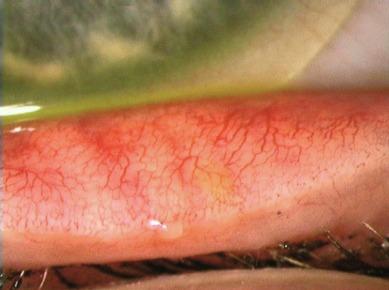
Meibomian gland expression is a simple and rapid provocative test that causes only mild discomfort to the patient. Anatomical considerations dictate that expression of the meibomian glands in the lower lid is the preferred procedure. The patient is instructed to gaze superiorly. In cases of mild meibomian orifice blockage, gentle pressure with the finger or thumb immediately below the lower lid margin, together with a slight rolling action of the finger or thumb toward the lid margin, will generally result in the appearance of a small amount of expressed material.
If nothing is expressed with use of the procedure described previously, a more complete or even total meibomian blockage is indicated. In such cases, a support needs to be placed behind the lower lid margin so that increased pressure can be applied to force expression of meibomian oils. This can be achieved by using a Mastrota paddle (OcuSOFT, Rosenberg, Texas, USA) ( Fig. 7.10 ), which is designed to gently and effectively express meibum from the meibomian glands. The lower lid is gently retracted, and the Mastrota paddle is positioned between the eyelid and the eye, parallel to the glands. A finger or cotton tip applicator applies gentle pressure to the outer lid. This procedure can be carried out with or without anaesthesia.
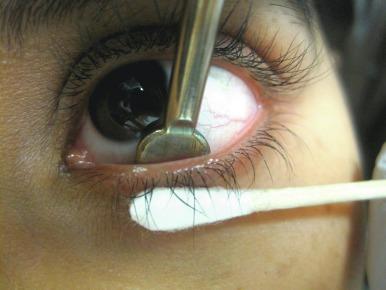
Korb et al. have designed a custom diagnostic hand-held meibomian gland expression instrument that can be used as an alternative to manual expression ( Fig. 7.11 ). The Meibomian Gland Evaluator (TearScience, Morrisville, North Carolina, USA) delivers constant force for meibum expression. The instrument has a flat rectangular contact surface area, of approximately 40 mm 2 , with rounded edges that applies pressure to approximately one-third of the lower eyelid, allowing for direct application of force to, and the simultaneous expression of, approximately eight meibomian glands. The precise contact surface area dimensions are 8.76 × 4.45 mm = 38.95 mm 2 . The instrument is designed to exert a constant force of 1.25 g/mm 2 .
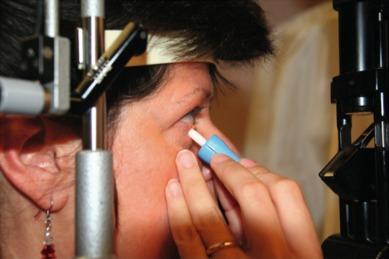
Sudden release of a blockage when applying firm pressure can result in copious expression of apparently dehydrated material in the form of a thick stream, akin to the result of forcefully squeezing a toothpaste tube; this is referred to as an ‘inspissated’ secretion. The extent of these inspissated secretions can be graded by using the grading scale for CL-MGD presented in Appendix A . It is not certain whether increased lipid is a result of (1) true hypersecretion of the meibomian glands or (2) damming of secretions in the presence of mild obstruction. This appearance is accompanied by symptoms of blurry vision, greasy lenses, dry eyes and reduced tolerance to lens wear. In severe cases where the meibomian orifices are blocked, gland secretion may be absent.
The absence of oil globules at the meibomian gland orifices when applying gentle pressure to the lids could indicate normality, hyposecretion or obstructive CL-MGD. If oil globules are not observed on the lid margins of a symptomatic contact lens wearer after application of gentle pressure, the patient may have a condition that Blackie et al. referred to as ‘non-obvious MGD’. In such cases, it may be necessary to conduct a provocative test to establish the state of health of the meibomian glands. This can be achieved be manual expression of the glands so that the quality of the expressed meibum can be assessed (see later).
Examination of the lid margins using diffuse illumination at approximately × 20 magnification often reveals the presence of small, oily globules at the orifices of the meibomian glands in patients suffering from CL-MGD.
The clarity of expressed meibum can be observed by examining the lid margins by using diffuse illumination at approximately × 0 magnification. The expressed meibum in a patient without CL-MGD can appear as small, clear, oily globules at the orifices of the meibomian glands ( Fig. 7.12 ). Viewing the lid margins against the dark background of the pupil or against a dark coloured iris, as shown in Figure 7.12 , will enhance the view of the expressed material.
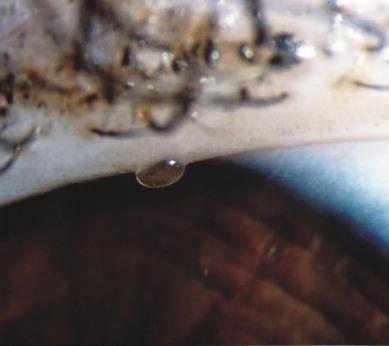
In patients with CL-MGD, the meibum may appear to be slightly murky ( Fig. 7.13 ). In more severe cases of CL-MGD, the meibum takes on an almost opaque waxy, milky-yellow colour ( Fig. 7.14 ).
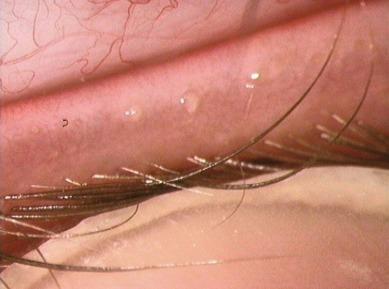
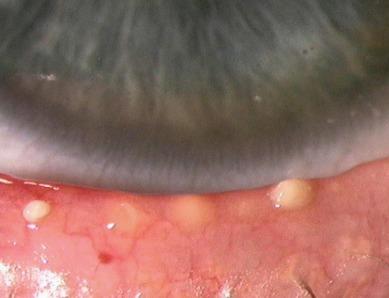
According to Ong and Larke, 20% of non–contact lens wearers show some loss of clarity of expressed meibomian oils, and opaque oils can be expressed from 6% of non–contact lens wearers. These figures rise to 30% and 11%, respectively, in contact lens wearers.
Ong and Larke reported that among contact lens wearers, about 10% of patients who complain of blurred vision and dryness can be demonstrated to have abnormal meibum.
Meibum samples collected by Hagedorn et al. from contact lens wearers without MGD showed large, circular aggregates with low surface roughness, whereas meibum samples from those with CL-MGD showed more lipid aggregates, greater size variability and higher surface roughness. Worn lenses of those with CL-MGD had a few large tear film deposits with lower surface roughness, whereas lenses from those without MGD had many small lens deposits with higher surface roughness.
Care must be exercised when interpreting studies of expressed meibum, given that expression technique influences the relative amount of phospholipids in the resulting sample. Kunnen et al. found that the meibomian gland evaluator method returned smaller polar lipid quantities than the cotton bud approach. The highest amounts of phospholipids were detected with the cotton bud expression technique and the lowest with the meibomian gland evaluator technique. Cleaning the eyelid margin before expression was not found to affect the lipid composition of the sample. This may be a consequence of the more forceful expression resulting in cell membrane contamination or higher risk for tear lipid contamination as a result of reflex tearing.
Frothing or foaming of the lower tear meniscus is sometimes observed in CL-MGD ( Fig. 7.15 ), especially toward the outer canthus. This may be caused by lowering of the surface tension of the tear film as a result of the lipid layer being absent or abnormal.
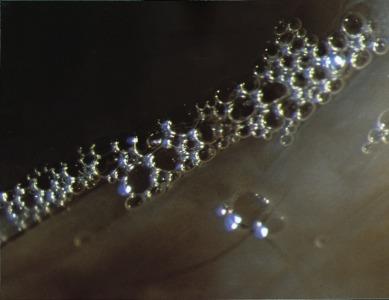
Clinical and cytological studies indicate that obstructive MGD is caused by blockage of the meibomian gland orifices by desquamated epithelial cells that tend to aggregate in keratotic clusters, which results in alteration of the contribution of meibomian glands to the pre-corneal tear film. Plugs of keratinised epithelium and dried lipid secretions that block meibomian gland orifices in CL-MGD can sometimes be observed with the slit lamp biomicroscope ( Fig. 7.16 ).
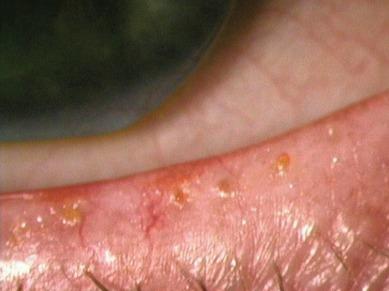
Become a Clinical Tree membership for Full access and enjoy Unlimited articles
If you are a member. Log in here